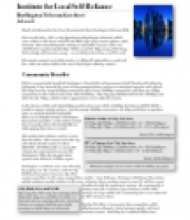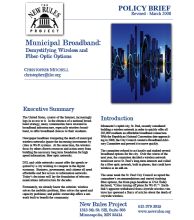
Fast, affordable Internet access for all.

Fiber to the Home
There are communities across the country that have found success building and operating their own broadband networks. Despite the caricature that municipal broadband invariably leads to boondoggles, that's just simply not the reality. That's part of the reason why I think the FCC needed to include municipal representation on these panels. There's a lot of fear, uncertainty, and doubt that's built up around municipal broadband that the FCC needs to be addressing on a factual basis. By not including municipal broadband on these panels I couldn't help but wonder if either the FCC was buying into these falsehoods or if they just didn't think municipal broadband was a significant enough player to include.The current FCC approach is akin to starting the Interstate Highway system with a series of workshops featuring horse breeders. In the meantime, the Economist has recognized the need for US regulators to get with the times. Fiber is the future - if it weren't for profit-maximizing companies and their lobbyists, talk of DSL would be followed by laughs.
With broadband networks, the role of the state has less to do with limiting handouts than increasing choice. Fibre-optic networks can be run like any other public infrastructure: government, municipalities or utilities lay the cables and let private firms compete to offer services, just as public roadways are used by private logistics firms. In Stockholm, a pioneer of this system, it takes 30 minutes to change your broadband provider. Australia’s new $30 billion all-fibre network will use a similar model.
As promised a few weeks ago, Ellen Perlman has written a piece on the story behind the Lafayette, Louisiana publicly owned FTTH network. This might just be the best network available in the U.S. in terms of offering the fastest speeds at the more affordable prices and offering the most benefit to the community. The path was certainly not easy nor quick but they are now offering services. The video below is a good example of how communities can respond to incumbents that prefer to advertise and lie rather than invest in networks. Fortunately the folks down in Louisiana didn't take Slick Sam lying down - they confronted him and are building a modern network to ensure Lafayette can flourish in the future. They no longer have to beg absentee-run networks for upgrades.
Currently, over 4,000 locations are served with our fiber-to-the-home network, which represents about 30 percent of our entire network. For these customers, thanks to the benefits of fiber optics, we can deliver high-speed Internet services up to 40 Mb (both upload and download) and a host of advanced television services including multiple streams of high-definition television, digital video recording, and on-demand services.For those who claim that people in rural areas just don't understand broadband or don't want it, this company has an answer:
One specific example the fiber optic network capacity can have on a business is Northwood DNA, Inc. This is a business operating in a very rural area, Becida, MN, that provides DNA sequencing and genotyping services globally. The services they provide require receiving and sending large data files electronically. Prior to the deployment of the fiber optic network, their business was only able to report two to three test results per day. Today, with the benefits of the all fiber optic network, they report over 50 test results per day.The full story starts on page 9 of the 2009 July FTTH Prism.
"There are two primary components to building this system. One component is taking longer than we thought and the other is happening much faster than we anticipated", said Harold DePriest, President and CEO. "The end result is that services will be available to the entire cities of Chattanooga, East Ridge and Red Bank by summer of 2010." DePriest says once in place, EPB's fiber optic network will be the largest of its kind in the country.However, Chattanooga has suffered the same problem that has plagued other publicly owned broadband projects around the country: incumbent telco and cableco lawyers. Comcast has sued Chattanooga in multiple courts in an attempt to limit competition (see here, here, here, and here for a few examples). As with these cases across the country (from Monticello, MN to Bristol, VA, to Lafayette, LA), the incumbents have lost the cases but successfully slowed the build-out, which hurts the community while padding company profits for an extra couple of years. The network will offer symmetrical speeds of 10-50Mbps while keeping costs lower than the standard prices in the market.
Salisbury, a city of nearly 30,000 in North Carolina, has started building its full fiber-to-the-home network. Salisbury had some difficulty in funding the network at first due to the collapsing economy last year. However, they securing financing in November 2008 and have now started building the network. A recent Salisbury Post article notes that Atlantic Engineering Group is installing conduit. However, residents will have to wait more than a year to take any services. They still have to build the multi-million dollar head end. They already have agreements covering access to the telephone polls -- which are owned by Duke Energy and AT&T.

ILSR issued a report in 2011 that updates this case study: Learning from Burlington Telecom: Some Lessons for Community Networks
Benoit Felten of FiberEvolution.com interviews Tim Nulty (former GM of Burlington Telecom, currently working on massive rural FTTH network in Vermont) at the Freedom to Connect Conference. Covers many topics, especially the economics of FTTH and why the public sector should invest in these networks.

The Municipal & Utility Guidebook to Bringing Broadband Fiber Optics to Your Community is a free, comprehensive guide to the economic and quality-of-life benefits of robust fiber infrastructure. It examines in detail four communities that have successfully deployed fiber-to-the-home (FTTH) services to their citizens and businesses. “This guidebook helps government leaders build a strong case for investing in FTTH infrastructure,“ said Alan Shark, Executive Director of PTI. “With thorough analysis, interviews and painstaking research, it sets forth strategies that, if followed, will help American communities whose broadband needs are not being met by current market dynamics to prosper in the information age.“

The United States, creator of the Internet, increasingly lags in access to it. In the absence of a national broadband strategy, many communities have invested in broadband infrastructure, especially wireless broadband, to offer broadband choices to their residents. Newspaper headlines trumpeting the death of municipal wireless networks ignore the increasing investments by cities in Wi-Fi systems. At the same time, the wireless focus by others diverts resources and action away from building the necessary long term foundation for high speed information: fiber optic networks. DSL and cable networks cannot offer the speeds required by a city wishing to compete in the digital economy. Business, government, and citizens all need affordable and fast access to information networks. Today's decisions will lay the foundation of telecommunications infrastructure for decades. Fortunately, we already know the solution: wireless solves the mobility problem; fiber solves the speed and capacity problems; and public ownership offers a network built to benefit the community.